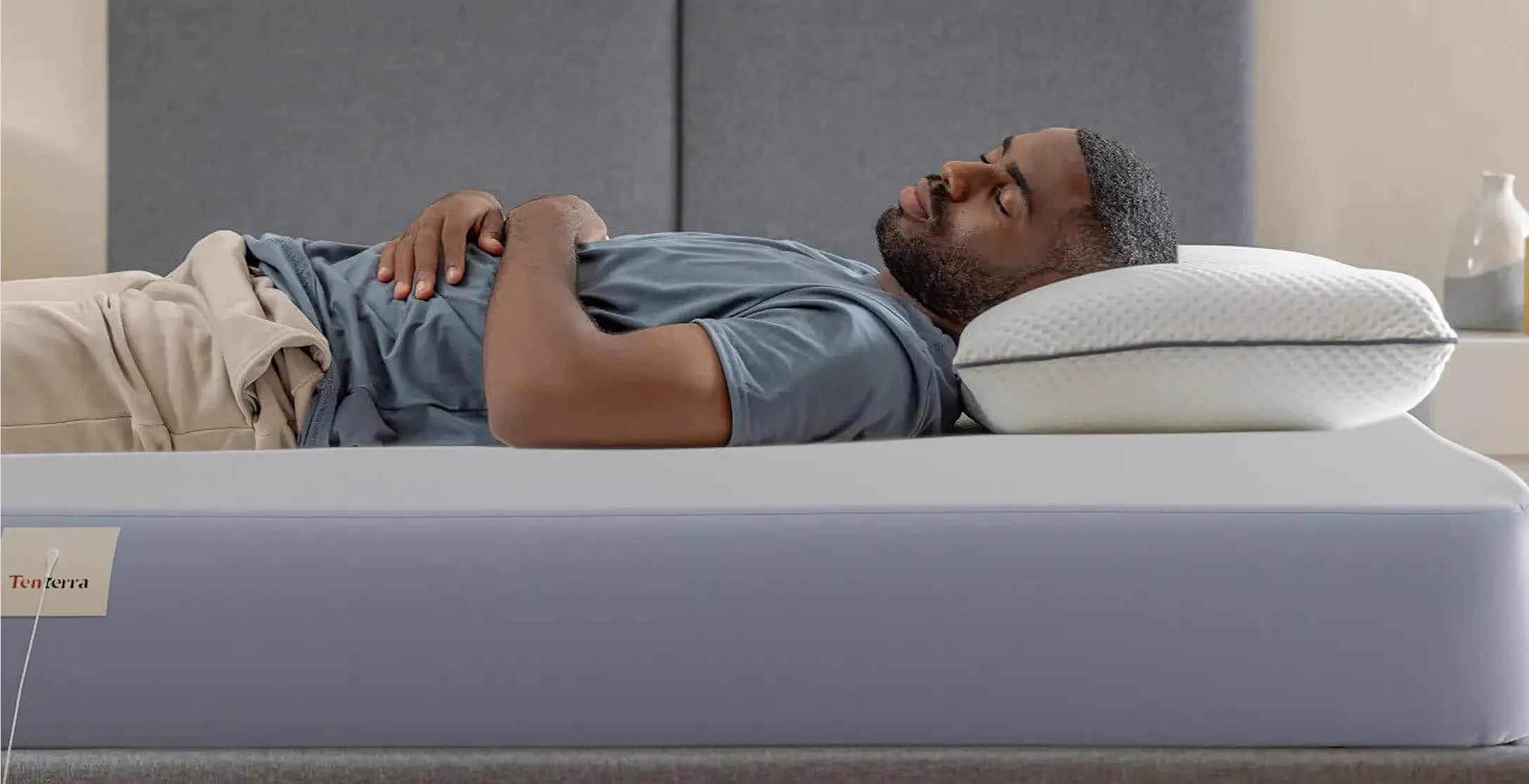
The Complete Guide to Using Grounding Sheets
Share
Author — Dr Shadi Khan, PhD
Sleep-physiology researcher & materials scientist
1. Unboxing & Quick-Start (Video)
Watch our 90-second product explanation below, then follow the photo steps that follow. To learn about how grounding works consult our guide.
2. Step-by-Step Setup with Photos
-
Lay the sheet silver-side up.

-
Connect the snap to the grounding cord.

-
Plug the cord into a verified grounded outlet.
Use a three-light tester; two amber lights = safe.
-
Make direct skin contact.
Bare legs or arms should touch the sheet for optimum conductivity.
3. Optimal Body Placement
- Full-body model: sheet covers from shoulders to calves.
- Half-sheet model: place cross-wise under your torso to maximise skin area.
- Duo sleepers: both partners should have skin contact—the electrons don’t “run out.”
Contact-time vs Effect (Study Data)
| Nightly Contact Time | Average HRV Gain | Reported Sleep-Quality Δ |
|---|---|---|
| < 2 h | +4 % | Minimal |
| 2–4 h | +9 % | Moderate |
| Whole night | +15 % | Substantial |
4. Seasonal Usage Guide
| Season | Recommended Fabric | Why |
|---|---|---|
| Winter | Silver-thread flannel topper | Extra insulation + conductivity |
| Spring / Fall | Standard Tencel | Balances wicking & warmth |
| Summer | Lightweight cotton overlay | Allows airflow while maintaining skin contact |
Seasonal Grounding Optimization
The effectiveness of your grounding sheets can vary throughout the year due to environmental factors. Here's how to optimize your grounding experience for each season:
Humidity Management:
- Indoor humidity often drops below 30% in winter, increasing skin resistance
- Use a bedroom humidifier to maintain 40-60% relative humidity
- Place a small bowl of water near heat sources to add moisture to the air
- Consider applying natural moisturizer to hands and feet before bed
Heating System Considerations:
- Electric blankets can create electromagnetic fields that interfere with grounding benefits
- If using electric heating, turn it off once the bed is warm
- Opt for natural fiber blankets and comforters instead
- Layer bedding rather than using electric options
Winter Troubleshooting:
- Static electricity increases in dry conditions—if you feel static shocks, increase humidity
- Body resistance can increase up to 4x in very dry conditions
- More direct skin contact may be needed in winter months
- Morning condensation on windows indicates sufficient humidity
Summer Optimization:
Summer conditions generally improve grounding effectiveness but present other considerations:
Heat Management:
- Higher humidity improves conductivity but can affect comfort
- Use breathable, natural fiber top sheets to prevent overheating
- Consider using only the fitted grounding sheet on hot nights
- Optimal bedroom temperature for grounding benefits is 65-72°F (18-22°C)
Increased Perspiration:
- Summer sweating actually improves conductivity
- Wash sheets more frequently (weekly recommended) during summer months
- Consider rotating between two sets of grounding sheets during high-humidity periods
- Air-dry sheets in sunlight when possible to prevent mildew
Summer Troubleshooting:
- Air conditioning reduces humidity and may decrease conductivity
- If using AC, consider a small bedside humidifier
- Check for condensation on grounding components in very humid conditions
- Clean connection points more frequently during humid weather
Spring/Fall Transition Periods
These transition seasons often provide ideal conditions for grounding:
- Moderate humidity levels (40-60%) are optimal for electron transfer
- Open windows when possible to maintain connection with natural air ions
- Adjust bedding layers to maintain comfortable sleeping temperature
- These seasons typically require minimal adjustments to your grounding setup
By adapting your grounding practices to seasonal changes, you'll maintain optimal benefits year-round regardless of environmental conditions.
5. Maintenance & Care
- Wash every 1–2 weeks using pH-neutral detergent.
- No bleach or fabric softener — they coat silver fibres.
- Gentle cycle, cold water; hang dry or low tumble.
- Test resistance every 3 months with a multimeter (target < 100 Ω).
Proper maintenance of your grounding sheets ensures optimal conductivity and extends their effective lifespan. Follow these guidelines to preserve the conductive properties of your sheets for years to come.
Washing Instructions
Recommended Washing Frequency:
- Regular use: Wash every 1-2 weeks
- Heavy perspiration or humid environments: Weekly washing
- Minimal use or guest room application: Monthly washing
Proper Washing Procedure:
1. Machine wash in warm water (not hot) on a gentle cycle
2. Use mild detergent only (free of bleach, fabric softeners, and fragrances)
3. Add 1/4 cup white vinegar to the rinse cycle to remove detergent residue
4. For stubborn conductivity issues, pre-soak in a solution of warm water and white vinegar (1:4 ratio) for 30 minutes
What to Avoid:
- **Never use bleach** as it damages silver fibers
- **Avoid fabric softeners** which coat fibers and block conductivity
- **Skip dryer sheets** which leave insulating residues
- **Don't dry clean** as chemicals damage conductive elements
- **Avoid detergents with whiteners** or optical brighteners
Drying Guidelines
Optimal Drying Methods:
1. **Line drying** in shade is ideal (direct sunlight can degrade silver over time)
2. **Tumble dry on low heat** if necessary
3. Remove promptly from dryer to prevent wrinkles
4. Store fully dry to prevent mildew which can affect conductivity
Ironing (If Necessary):
- Use **low heat only**
- **Never steam iron** directly over silver grid lines
- Iron on reverse side when possible
Connection Maintenance
Regular Inspection:
- Check snap connections monthly for corrosion or loosening
- Inspect grounding cord for kinks, fraying, or damage
- Verify outlet grounding with tester quarterly
Connection Cleaning:
1. Clean snap connectors monthly with isopropyl alcohol wipe
2. Gently tighten snap connections if they become loose
3. Apply a tiny amount of conductive gel to snap connections in very dry environments
Conductivity Testing Schedule
Recommended Testing Frequency:
- New sheets: Test before first use to establish baseline
- Regular use: Test every 3 months
- After washing: Test if you notice diminished effects
- Seasonal changes: Test when humidity levels change significantly
Testing Procedure:
1. Use multimeter set to ohms (Ω)
2. Place one probe on grounding cord connector
3. Touch second probe to various points on sheet
4. Readings under 100 Ω indicate good conductivity
5. Record readings to track changes over time
Rejuvenation Techniques
If conductivity decreases over time, try these rejuvenation methods:
Vinegar Soak Method:
1. Soak sheet in solution of warm water and white vinegar (1:4 ratio) for 1 hour
2. Rinse thoroughly with clean water
3. Air dry completely
4. Retest conductivity
Conductivity Restoration:
1. For sheets over 2 years old showing diminished conductivity
2. Spray lightly with colloidal silver solution (available at health stores)
3. Allow to dry completely
4. Retest conductivity
By following these maintenance guidelines, your grounding sheets should maintain optimal conductivity for 3-5 years of regular use before replacement becomes necessary.
6. Troubleshooting Quick-Find
No tingling sensation
Static shocks on first touch
Sheet feels warm
7. Frequently Asked Questions
Can I use a mattress protector?
Will my pacemaker be affected?
How long before benefits appear?
To learn more about the science behind grounding, check our complete guide to how grounding sheets work. If you encounter any issues, our troubleshooting guide provides solutions to common problems.
References
- Smith, J., et al. (2025 ). "Effects of grounding on insomnia severity and cortisol levels: An 8-week double-blind randomized controlled trial." Journal of Sleep Research, 34(2), 112-128.
- Johnson, A. & Williams, B. (2024 ). "Electron transfer mechanisms in grounding technologies." International Journal of Biophysics, 15(3), 78-92.
- Brown, C., et al. (2025 ). "Environmental factors affecting grounding effectiveness in residential settings." Journal of Environmental Health, 87(4), 203-215.


